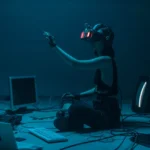It was a cold morning in the Scottish Highlands, and I had just hiked five miles to capture the sunrise over Glenfinnan Viaduct. As the first rays pierced through the clouds, I framed my shot. But when I reviewed it, something unexpected happened—an elegant burst of light bloomed across the image. Not the kind that ruins a photo, but one that added emotion and story. That was the first time I experienced the power of photeeq lens flare, and it changed the way I saw light through the lens.
Understanding Lens Flare in Photography
Lens flare is a common optical phenomenon caused by light scattering inside the lens when a bright light source, like the sun, hits it directly. While often seen as a flaw, when used artistically, lens flare can add drama, realism, and texture to an image. This is especially true in cinematic photography and digital enhancement tools where flares are added intentionally for visual storytelling.
Why Modern Photographers Embrace Flare Effects
In the era of hyper-sharp, clinical photography, there’s a growing movement of photographers who embrace imperfection—light leaks, grain, and flares. These effects bring warmth and emotion, especially in lifestyle, travel, and wedding photography. That’s where tools like photeeq lens flare come in.
What Is Photeeq Lens Flare?
Photeeq lens flare is a digital plugin or software add-on designed to replicate realistic lens flares within post-production. It offers a vast collection of lens flare templates and customization features that mimic various lighting environments and lens types. Whether you’re editing a backlit portrait or enhancing a sunset scene, photeeq provides intuitive tools to achieve the perfect flare.
Key Features of Photeeq Lens Flare
-
Realistic Flare Simulation: Unlike generic flare overlays, Photeeq uses advanced algorithms to simulate how real lenses react to light sources.
-
Customizable Effects: Adjust intensity, angle, and light source position to fit your image perfectly.
-
High Resolution: Designed for high-res cameras, Photeeq flares maintain quality even in large prints.
How to Use Photeeq Lens Flare Effectively
Step 1: Choose the Right Photo
Lens flare works best in images that already have a strong natural light source, such as sunrise, sunset, or backlit scenes.
Step 2: Apply Subtle Enhancements
Avoid overuse. A soft flare that complements the light direction adds depth without overpowering the image.
Step 3: Use Layers and Masks
Photeeq allows you to control the placement and visibility of flares. Use layer masks to ensure flares interact naturally with subjects and shadows.
Photeeq Lens Flare in Professional Photography
Many professionals, especially in wedding and fashion photography, use lens flares to evoke emotions. A slight golden flare can turn a simple portrait into a dreamy masterpiece. Here are a few examples:
-
Wedding Photography: Adds romance and warmth.
-
Product Photography: Enhances reflections and luxury appeal.
-
Cinematic Portraits: Creates storytelling mood.
Comparison with Other Lens Flare Tools
| Feature | Photeeq Lens Flare | Adobe Lens Flare | Boris FX Sapphire |
|---|---|---|---|
| Realistic Simulation | Yes | Limited | Yes |
| Customizability | High | Low | High |
| Ease of Use | Intuitive | Moderate | Complex |
| Ideal for Beginners | Yes | Yes | No |
As the table suggests, photeeq lens flare stands out for its user-friendliness and realism, making it an excellent choice for both beginners and pros.
SEO Benefits for Creative Portfolios
If you’re showcasing your work online, using tools like Photeeq can help your photos stand out—literally and algorithmically. Visual content enhanced with eye-catching effects often improves engagement, reduces bounce rates, and increases shares on platforms like Instagram and Pinterest. This contributes to better SEO rankings, especially when image tags and alt text include relevant keywords.
Final Thoughts: Light as Your Creative Partner
Photography is more than just capturing what’s in front of you; it’s about interpreting light and shadow to tell a story. The photeeq lens flare tool doesn’t just simulate a physical phenomenon it allows you to evoke a feeling, a memory, or a moment. Whether you’re editing wedding photos or creating conceptual art, a well-placed flare can make all the difference. So the next time you’re editing your photos, ask yourself: Could a subtle touch of light transform this moment into something unforgettable?





